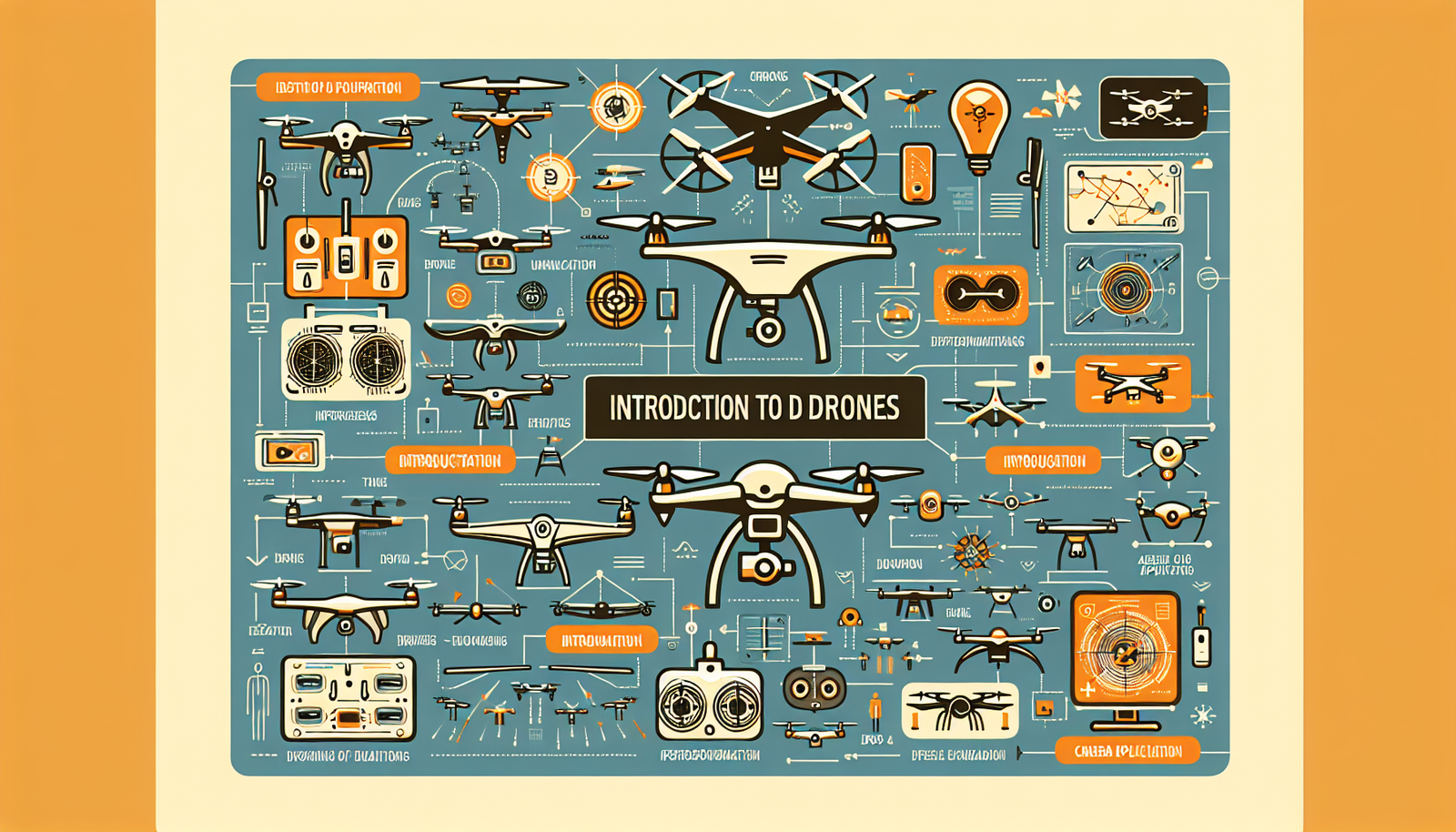So you’ve probably heard the term “drone” tossed around quite a bit lately, but do you really know what it means? Simply put, a drone is an unmanned aerial vehicle (UAV) that can be remotely controlled or fly autonomously. These fascinating gadgets are equipped with various sensors, cameras, and even GPS systems, allowing them to undertake a wide range of tasks. But how exactly do they work their magic? Let’s take a closer look at the inner workings of these buzzing, high-flying machines.

Table of Contents
ToggleWhat is a Drone?
Definition
A drone, also known as an unmanned aerial vehicle (UAV), is an aircraft without a human pilot onboard. It is remotely controlled or can fly autonomously, following pre-programmed plans or using complex systems that allow it to perform various tasks. Drones come in all shapes and sizes, ranging from small consumer drones to large military aircraft.
History
The concept of drones dates back to the early 20th century when the first attempts at creating unmanned aerial vehicles were made. However, it was not until the late 20th century that drones became more widely used, primarily for military purposes. Over the years, technological advancements have made drones more accessible and affordable, leading to their adoption in a wide range of industries and applications.
Types of Drones
Fixed-Wing Drones
Fixed-wing drones are designed to resemble conventional airplanes, with fixed wings and a fuselage. They rely on aerodynamic forces to generate lift and require forward motion to stay airborne. Fixed-wing drones are known for their efficiency and long flight times, making them ideal for applications such as aerial mapping, surveying, and monitoring large areas.
Multirotor Drones
Multirotor drones, also referred to as quadcopters or hexacopters, are the most common type of consumer drones. They have multiple rotors (typically four or six) arranged in a symmetric pattern. Multirotor drones are highly maneuverable and can hover in place, fly in any direction, and perform intricate flight maneuvers. They are popular for recreational use, aerial photography and videography, and even racing.
Single-Rotor Drones
Single-rotor drones, also known as helicopters, have a large main rotor and a smaller tail rotor for stability. They are capable of vertical takeoff and landing and can stay airborne in one position without moving forward. Single-rotor drones offer better stability and lifting capacity compared to multirotor drones, making them suitable for heavy payloads and applications such as aerial surveying, inspection, and search and rescue operations.
Hybrid Drones
Hybrid drones combine the features of fixed-wing and multirotor drones. They have both fixed wings and multiple rotors, allowing them to take off and land vertically while also benefiting from efficient forward flight. Hybrid drones offer the flexibility of vertical takeoff and landing in confined spaces, extended flight range, and high payload capacity. They are commonly used in applications like aerial mapping, surveillance, and cargo transportation.
Components of a Drone
Frame
The frame is the main structure of a drone, providing support and housing for all the components. It is typically made of lightweight materials like carbon fiber or plastic to minimize the weight of the drone and increase its maneuverability.
Propellers
Propellers, also known as rotors, generate the necessary thrust to lift the drone off the ground and propel it through the air. The number and arrangement of the propellers depend on the type of drone. Multirotor drones have multiple propellers, while fixed-wing drones usually have one or two large propellers.
Motors
Motors convert electrical energy from the drone’s battery into rotational motion, which drives the propellers. The power and efficiency of the motors influence the drone’s flight performance, including speed, maneuverability, and payload capacity.
Flight Controller
The flight controller is like the brain of the drone. It is a computerized system that processes and analyzes data from various sensors and controls the drone’s behavior. The flight controller receives inputs from the pilot or an autonomous system and adjusts the drone’s motors and control surfaces to maintain stability and execute flight commands.
Battery
The battery provides the necessary electrical energy to power the drone’s motors, flight controller, and other electronic components. Battery technology has a significant impact on flight time, as drones heavily rely on energy storage capacity to stay airborne for extended periods.
Sensors
Drones are equipped with various sensors to gather data about their surroundings and ensure safe and accurate flight. Common sensors include GPS receivers for navigation and positioning, altimeters to measure altitude, gyroscopes and accelerometers for stabilization, and obstacle detection sensors for collision avoidance.
Camera
Many drones are equipped with cameras or cameras mounted on gimbals to capture high-quality photos and videos from an aerial perspective. The camera’s resolution, image stabilization capabilities, and range of motion greatly influence the drone’s suitability for photography and videography purposes.
How Does a Drone Work?
Flight Controls
Drones are controlled using a remote controller or a mobile device. The pilot inputs commands, such as pushing the joystick forward to make the drone move forward or tilting it to change the drone’s orientation. These commands are transmitted to the drone’s flight controller, which interprets them and adjusts the drone’s motors accordingly.
Stabilization
Stabilization is crucial for maintaining the drone’s balance and stability during flight. Drones utilize gyroscopes and accelerometers to measure angular and linear acceleration, respectively. The flight controller uses this data to make real-time adjustments to the drone’s motors, ensuring it stays level and steady.
Propulsion
Drones achieve flight through the propulsion generated by the rotation of the propellers. By varying the speed and direction of rotation of the propellers, the drone can move in different directions or hover in place. The flight controller continuously adjusts the motor speeds to control the drone’s movement and stability.
Navigation
Navigation is made possible through the integration of GPS technology with flight controllers. GPS enables drones to determine their position, altitude, and speed accurately. This allows for precise waypoint navigation and the execution of autonomous flight missions.
Communication
Drones rely on wireless communication systems to establish a communication link with the pilot or ground control station. This link allows for real-time telemetry data transmission, video streaming, and remote control commands. Communication systems can use various frequencies and protocols, such as Wi-Fi or radio frequencies, depending on the drone’s range and purpose.

Autonomous Features
Waypoint Navigation
Modern drones can be programmed to follow pre-defined waypoints or paths autonomously. The pilot sets the coordinates and altitude of each waypoint, and the drone will navigate between them, executing specific actions or capturing data along the way. Waypoint navigation enables drones to perform complex tasks, such as aerial mapping or precision agriculture.
Obstacle Avoidance
Obstacle avoidance is a crucial feature in drones to enhance safety and prevent collisions with objects in their flight path. Drones utilize sensors, such as ultrasonic sensors, LiDAR, or computer vision systems, to detect and avoid obstacles. The sensors provide feedback to the flight controller, allowing the drone to change its flight path and maintain a safe distance from potential obstacles.
Follow Me Mode
Follow Me mode enables drones to track and follow a moving subject or an operator automatically. By using GPS or a visual tracking system, the drone can lock onto a target and adjust its position and altitude accordingly. This feature is popular among action sports enthusiasts, allowing them to capture dynamic footage without the need for manual piloting.
Return to Home
Return to Home is a safety feature that allows drones to automatically fly back to their takeoff location. By utilizing GPS, the drone can navigate back to the exact coordinates where it was launched. This feature is particularly useful in case of low battery, signal loss, or an emergency situation.
Applications of Drones
Aerial Photography and Videography
Drones have revolutionized aerial photography and videography, providing a unique and accessible perspective. They are used in film productions, real estate marketing, event coverage, and social media content creation, allowing for stunning shots and dynamic aerial sequences.
Search and Rescue
Drones are increasingly being used in search and rescue operations. Equipped with thermal imaging cameras and sensors, they can locate missing persons or survivors in remote or hazardous areas quickly. Drones can cover large areas in a short time, providing crucial information to search teams and helping to save lives.
Delivery Services
Drone delivery services have emerged as a potential solution for transporting goods in a more efficient and cost-effective way. Companies are exploring the use of drones to deliver packages, medical supplies, or even food to remote areas or in emergency situations where traditional transportation methods are challenging.
Agriculture
Drones have found applications in agriculture, where they can aid in crop monitoring, mapping, and precision spraying. Equipped with multispectral or thermal cameras, drones can detect crop health issues, assess water or fertilizer needs, and precisely apply treatments, leading to improved crop yields and reduced environmental impact.
Surveying and Mapping
Drones have transformed the field of surveying and mapping, making it faster, more accurate, and cost-effective. They can capture high-resolution aerial imagery or create precise 3D models of terrain and structures. Drones are particularly useful for land surveying, infrastructure inspections, and construction site management.
Environmental Monitoring
Drones play a significant role in environmental monitoring and conservation efforts. They can be equipped with sensors to monitor air quality, water pollution, or wildlife populations. Drones enable researchers and conservationists to access remote or sensitive areas, collect data, and monitor environmental changes more efficiently.
Drone Regulations
Registration
Many countries have implemented regulations requiring drone owners to register their drones. Registration helps in identifying the owner and ensuring accountability in case of any incidents or violations. It also helps aviation authorities track the number of drones in operation and enforce safety guidelines.
Operating Limits
Drone regulations establish operating limits regarding altitude, flight range, and restricted areas. These limits aim to ensure the safety of airspace, protect privacy, and prevent interference with manned aircraft operations. Drone operators must comply with these limits and avoid flying in prohibited or sensitive areas, such as airports or government installations.
Safety Guidelines
Drone regulations also provide safety guidelines for drone operation. These guidelines may include maintaining visual line of sight while operating, respecting privacy, avoiding crowded areas or public events, and ensuring the pilot’s competency through training and certification. Adhering to safety guidelines helps prevent accidents and promotes responsible drone use.
Advantages of Drones
Efficiency and Cost-Effectiveness
Drones offer significant efficiency and cost advantages in various industries. They can perform tasks faster and more efficiently than traditional methods, reducing the time and resources required. Drones eliminate the need for human operators in hazardous or labor-intensive tasks, saving costs associated with manpower and improving overall productivity.
Improved Safety and Accessibility
Drones can access remote or dangerous locations that are difficult or risky for humans to reach. They can inspect tall structures, navigate challenging terrains, or monitor hazardous environments. Their use reduces the risks associated with human involvement in dangerous activities, ensuring safety and minimizing injuries.
Versatility and Adaptability
Drones are highly versatile and adaptable to various applications and industries. With the use of different sensors, cameras, or payload attachments, drones can perform a wide range of tasks, from aerial photography to delivery services. Their flexibility allows for easy customization and integration with existing workflows or technologies.
Challenges and Concerns
Privacy Issues
The increasing use of drones raises concerns about privacy intrusion. Drones equipped with cameras can capture images or video footage of private properties or individuals without their consent, leading to potential privacy violations. Regulations and ethics play a vital role in ensuring responsible drone use and protecting privacy rights.
Air Traffic Management
As the number of drones in the airspace increases, integrating drones safely into the existing air traffic management system becomes a significant challenge. Ensuring separation between manned aircraft and drones, managing the increased traffic volume, and maintaining communication and control systems are crucial for safe and efficient drone operations.
Security Risks
Drones present potential security risks, such as unauthorized surveillance, smuggling, or interference with critical infrastructure. The ability of drones to fly in restricted areas or carry payloads makes them attractive for malicious activities. Developing countermeasures and implementing security protocols is essential to mitigate these risks and ensure public safety.
Public Perception
The public perception of drones is mixed, ranging from excitement about their potential to concerns regarding safety and privacy. Addressing public concerns, increasing awareness about responsible drone use, and educating the public about the benefits of drones can help foster a positive perception and acceptance of drones in society.
Future Trends
Increased Automation
The future of drones lies in increased autonomy and automation. Advances in artificial intelligence (AI) and machine learning enable drones to make intelligent decisions and adapt to changing environments. Fully autonomous drones capable of complex missions without human intervention are already being developed and will continue to evolve.
Integration with AI and Robotics
The integration of drones with AI and robotics expands their capabilities and applications. AI-powered drones can analyze data in real-time, making more informed decisions and enhancing their performance. Robotics technology allows for advanced payload capabilities, such as grabbing or manipulating objects, enabling drones to perform more complex tasks.
Advancements in Battery Technology
Improvements in battery technology are crucial for extending flight times and expanding the capabilities of drones. Longer flight times enable drones to cover larger areas, perform longer missions, or carry heavier payloads. The development of more efficient and lightweight batteries, as well as alternative power sources, will drive the future advancements in drone technology.
In conclusion, drones have become an integral part of many industries and applications, revolutionizing the way we capture images, perform tasks, and conduct operations. The versatility, efficiency, and cost-effectiveness of drones make them invaluable tools in various fields. However, addressing concerns such as safety, privacy, and security is crucial in ensuring the responsible and ethical use of drones. As technology continues to advance, drones will undoubtedly play an even more significant role in shaping the future, pushing the boundaries of what is possible in aerial operations.


